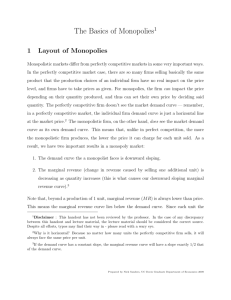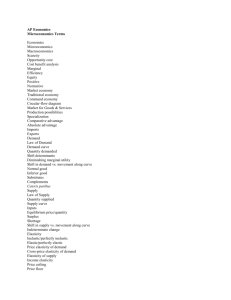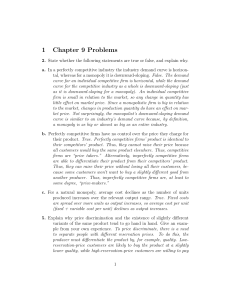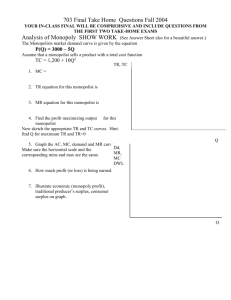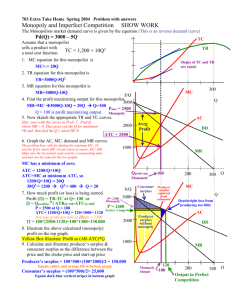File
advertisement
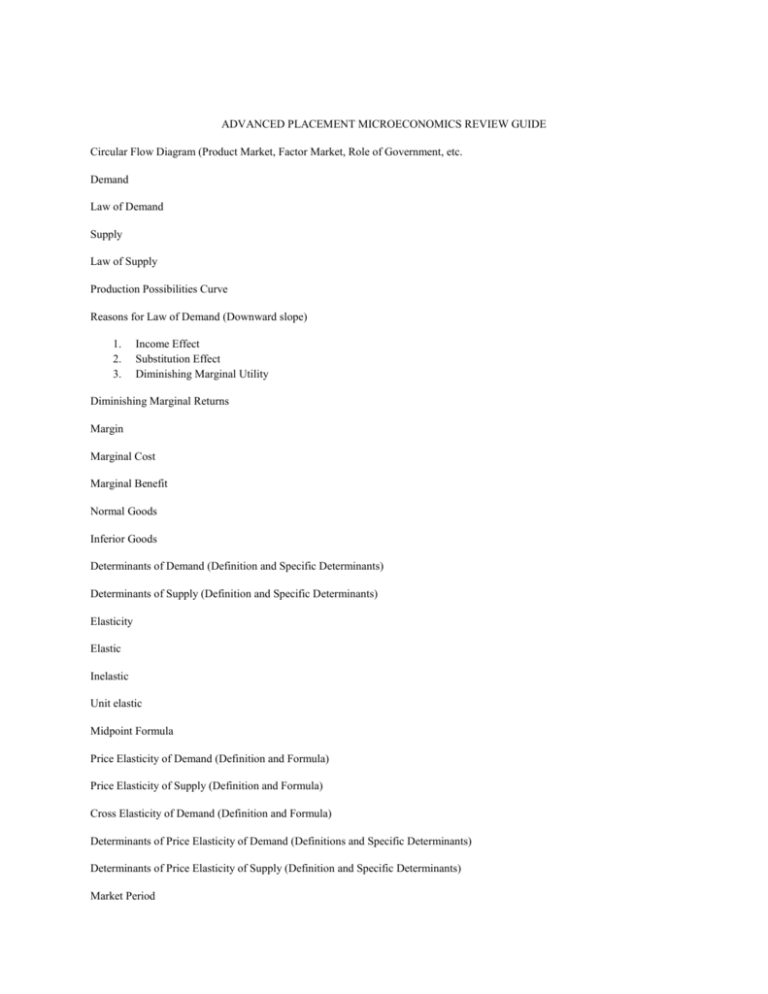
ADVANCED PLACEMENT MICROECONOMICS REVIEW GUIDE Circular Flow Diagram (Product Market, Factor Market, Role of Government, etc. Demand Law of Demand Supply Law of Supply Production Possibilities Curve Reasons for Law of Demand (Downward slope) 1. 2. 3. Income Effect Substitution Effect Diminishing Marginal Utility Diminishing Marginal Returns Margin Marginal Cost Marginal Benefit Normal Goods Inferior Goods Determinants of Demand (Definition and Specific Determinants) Determinants of Supply (Definition and Specific Determinants) Elasticity Elastic Inelastic Unit elastic Midpoint Formula Price Elasticity of Demand (Definition and Formula) Price Elasticity of Supply (Definition and Formula) Cross Elasticity of Demand (Definition and Formula) Determinants of Price Elasticity of Demand (Definitions and Specific Determinants) Determinants of Price Elasticity of Supply (Definition and Specific Determinants) Market Period Short Run Long Run Total Revenue Test Total Revenue Test: If P↑ and TR↑ => inelastic D If P↓ and TR↓ => inelastic D If P↑ and TR↓ => elastic D If P↓ and TR↑ => elastic D Utility Maximization Rule (Definition and Formula) Consumer Surplus Producer Surplus Price Ceiling Price Floor Externality Positive Externality (definition and consequences) Negative Externality (definition and consequences) Deadweight Loss Marginal Private Cost Marginal Private Benefit Marginal Social Cost Marginal Social Benefit Costs of Production Total Costs Implicit Costs Explicit Costs Normal Profit Accounting Profit Economic Profit ATC AVC AFC Why do the cost curves look the way they do? Why does MC intersect ATC and AVC at their lowest points? What causes cost curves to shift? Why is the MC curve an individual firm’s supply curve above the AVC? Where a firm is is earning economic profits (or losses) and describe the long-run adjustments that lead to the elimination of those profits (or losses.) What is the “shut-down” scenario? Perfect Competition 1. 2. 3. 4. What are the specific characteristics of a Perfectly Competitive industry? Price Taker vs. Price Maker Understand why the PC firm’s Demand curve is perfectly elastic (firms are price takers) and why D = MR = P. Be able to illustrate what happens in the short run regarding profits or losses and what happens in the long run as a result. Allocative Efficiency Productive Efficiency Monopoly 1. 2. 3. 4. 5. 6. 7. 8. 9. 10. 11. 12. 13. Marginal Revenue lies below Demand: Since a monopolist is the only seller of its product, in order to sell additional units, it must lower the price of all previous units, so its MR falls at a faster rate than the price it charges. There is Consumer Surplus in a single-price monopoly. The firm is achieving economic profit (TR – TC > 0). This is because it is able to restrict output to the MC = MR level in order to maximize profit TC is found by taking the firms ATC at the profit maximizing level of output and multiplying it by output. Just as in all markets, the firm’s MC curve sloped downward in the early level of output (due to increasing marginal returns) then upwards as output increases (due to the law of diminishing marginal returns). The MC intersects the ATC curve at its lowest point. You MUST know why this happens: because if the cost of the last unit produced was lower than the average unit, then average cost will decrease, and vise versa (remember your grade in class; if you do better on this test than you’ve averaged in the class, your average will go up!) Notice that there is Deadweight Loss in a monopoly. This means market failure. Resources are under-allocated towards the production of the good. Price Discrimination All Consumer Surplus from the single – price firm is turned into monopolist profit and producer surplus MR shifts up to align with D (P) price charged for the last unit sold is different for each unit, allowing the firm to extract the from each buyer exactly what he or she is willing to pay. Monopolist now produces at the profit maximizing level of output (MR = MC). P = MC, so allocative efficiency is achieved. Notice, productive efficiency is not achieved, as the monopolist is not producing at min. ATC. Lerner Index Formula Natural Monopoly Oligopoly (Definition and Specifics) 1. Game Theory 2. 3. Dominant Strategy Nash Equilibrium Monopolistic Competition 1. 2. 3. 4. 5. 6. D is more elastic than in monopoly; there are more substitutes for the product. MR lies below D (and P) b/c in order to sell additional output, firms must lower the price of all previous units of output. This firm is in equilibrium because ATC is tangent to the D curve. Due to low barriers to entry, if D were to shift out and P go up, more firms would enter, shift the D curve faced by the individual firm back in, lowering price back to the level of ATC. Although it appears to be close to min. ATC, this firm is not achieving min. ATC, so it is not productively efficient. At the profit maximizing level of output (where MR = MC) P does not equal MC (since P is greater than MR). Therefore, this firm is not achieving allocative efficiency. Monopolistically competitive firms are destined to earn only normal profits and the industry is inefficient since there is an under-allocation of resources towards the production of this good. Economic Rent Rent Seeking Behavior Factor (Resource) Markets Derived Demand Wage Taker vs. Wage Maker MRP MPP MRC MRP = MRC Least Cost Rule Profit Maximizing Rule Monopsony Roles of Government in the economy Public Goods vs. Private Goods 2 principles of taxation 3 kinds of tax policies Tax incidence Coase Theorem Lorenz Curve and Gini Coefficient Major Graphs to Know Production Possibilities Curve Demand, Supply, Equilibrium Consumer Surplus Producer Surplus Demand and Supply Shifts Left or right: What happens to Equilibrium Q and P? Price Ceilings (Surplus) Price Floors (Shortage) Perfectly Competitive Firm: Short Run Economic Profit; Long Run Only Normal Profit Perfectly Competitive Firm: Short Run Economic Loss; Long Run Only Normal Profit Perfectly Competitive Firm: Shut-Down Point Monopoly earning economic profit (include all curves and deadweight loss) Monopoly earning economic loss Monopolistic Competition: Long Run Equilibrium Perfectly Competitive Labor Market (Wage Taker) Monopsony (include deadweight loss) Positive Externality (with deadweight loss) Negative Externality (with deadweight loss)




